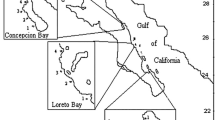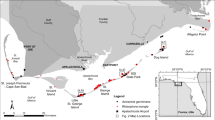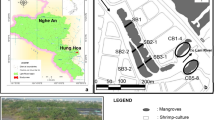Abstract
Key message
Mangroves in rapidly expanding Southeast Asian river deltas form floristically simple zones dominated by a few highly regenerative species adaptable or tolerant to rapid sedimentation and extensive river flooding.
Abstract
The size class distribution, community composition and spatial structure of five representative mangrove forests in the rapidly expanding Cimanuk river delta on Java were determined. These deltaic forests are species-poor (eight true mangrove species) and spatially segregated into three distinct floristic zones: (1) a fringing, low intertidal zone co-dominated by Avicennia marina and A. officinalis, with less abundant Bruguiera parviflora, Rhizophora apiculata, and R. mucronata; (2) a zone transitional between the low and mid intertidal in which Avicennia and Rhizophora spp. co-dominate; and (3) a mid intertidal zone dominated by R. mucronata and R. apiculata. Numerically dominated by seedlings (52,500–73,500 seedlings ha−1) and saplings (5,268–5,660 saplings ha−1), all five forests are relatively young and actively regenerating. Positive correlations of tree stem diameter and tree height with soil organic matter and P concentrations, salinity, the soil C/N ratio, pH, and silt/clay composition highlight the importance of soil factors in sustaining forest growth. The low diversity and relative structural simplicity of these rapidly growing and regenerating forests may be attributed to adaptation or tolerance to flooding and the rapid sedimentation and seaward expansion of the delta.



Similar content being viewed by others
References
Abdulhadi R, Suhardjono (1994) The remnant mangroves of Sei Kecil, Simpang Hilir, West Kalimantan, Indonesia. Hydrobiologia 285:249–255
Alongi DM (1989) The role of soft-bottom benthic communities in tropical mangrove and coral reef ecosystems. Rev Aq Sci 1:243–280
Alongi DM (1996) The dynamics of benthic nutrient pools and fluxes in tropical mangrove forests. J Mar Res 54:123–148
Alongi DM (2009) The energetics of mangrove forests. Springer, Dordrecht
Alongi DM (2011) Early growth responses of mangroves to different levels of nitrogen and phosphorus supply. J Exp Mar Biol Ecol 397:85–93
Ashton EC, Macintosh DJ (2002) Preliminary assessment of the plant diversity and community ecology of the Sematan mangrove forest, Sarawak, Malaysia. Forest Ecol Manag 166:111–129
Ball MC (1988) Organization of mangrove forests along natural salinity gradients in the Northern Territory: an ecophysiological perspective. In: Marshal DW, Loveday P (eds) Floodplain research. ANU, Canberra, pp 84–100
Becking JH, den Berger LG, Meindersma HW (1922) Vloed of mangrovebosschen in Ned.Indie. Tectona 15:561–611
Chapman VJ (1976) Mangrove vegetation. Cramer, Vaduz
Clarke PJ, Kerrigan RA (2000) Do forest gaps influence the population structure and species composition of mangrove stands in northern Australia? Biotropica 32:642–652
Dahdouh-Guebas F, Verheyden A, De Genst W, Hettiarachchi S, Koedam N (2000) Four decade vegetation dynamics in Sri Lankan mangroves as detected from sequential aerial photography: a case study in Galle. Bull Mar Sci 67:741–759
Dahdouh-Guebas F, Kairo JG, Jayatissa LP, Cannicci S, Koedam N (2002) An ordination study to view vegetation structure dynamics in disturbed and undisturbed mangrove forests in Kenya and Sri Lanka. Plant Ecol 161:123–135
de Haan JH (1931) Het een er ander over de Tjilatjapsche vloedboschen. Tectona 24:39–76
Ellison AM, Mukherjee BB, Karim A (2000) Testing patterns of zonation in mangroves: scale dependence and environmental correlates in the Sundarbans of Bangladesh. J Ecol 88:813–824
Ewel KC, Zheng S, Pinzon Z, Bourgeois JA (1998) Environmental effects of canopy gap formation in high rainfall mangrove forests. Biotropica 30:510–518
Feller IC, Whigham DF, McKee KM, O’Neill JP (2002) Nitrogen vs phosphorus limitation across an ecotonal gradient in a mangrove forest. Biogeochem 62:145–175
Havanods S (1987) Effects of mud lobster (Thalassina anomala) on plant succession in mangrove forests, Thailand. Bull Mar Sci 41:635–636
Hehannusa PE, Hadiwisastra S, St. Djuhanah (1976) Sedimentasi delta baru Cimanuk. Geol Indonesia 3:12–35
Legendre P, Legendre L (2012) Numerical ecology, 3rd edn. Elsevier, Amsterdam
Macnae W (1968) A general account of the fauna and flora of mangrove swamps and forests in the Indo-West Pacific region. Adv Mar Biol 6:73–270
Margalef R (1958) Information theory in ecology. Gen Syst 3:36–71
Paijmans P, Rollet B (1977) The mangroves of Galley Reach, Papua New Guinea. Forest Ecol Manag 1:119–140
Percival M, Womersley JS (1975) Floristics and ecology of the mangrove vegetation of Papua New Guinea. Dept Forests, Div Botany. P N G Botany Bull 8:1–96
Pool DJ, Snedaker SC, Lugo AE (1977) Structure of mangrove forests in Florida, Puerto Rico, Mexico and Costa Rica. Biotropica 9:195–212
Purbohadiwidjojo MM (1964) On the Cimanuk river delta, West Java. Bull Geol Sur Indonesia 1:35–38
Saenger P (2002) Mangrove ecology, silviculture and conservation. Kluwer, Dordrecht
Saintilan N (1998) Relationships between height and girth of mangroves and soil-water conditions in the Mary and Hawkesbury river estuaries, eastern Australia. Aust J Ecol 23:322–328
Sherman RE, Timothy JF, Battles JJ (2000) Small-scale disturbance and regeneration dynamics in a neotropical mangrove forest. J Ecol 88:165–178
Shinozaki K, Kira T (1961) The C-D rule, its theory and practical uses (intra-specific competition among higher plants). J Biol, Osaka City Univ 12:69–82
Smith TJ III (1992) Forest structure. In: Robertson AI, Alongi DM (eds) Tropical mangrove ecosystems. American Geophysical Union, Washington DC, pp 101–136
Sokal RR, Rohlf FJ (2012) Biometry, 4th edn. WH Freeman, San Francisco
Stieglitz T, Ridd P, Müller P (2000) Passive irrigation and functional morphology of crustacean burrows in a tropical mangrove swamp. Hydrobiologia 421:69–76
Sukardjo S (1984) The ecology of natural regeneration of the mangrove forest in the Cimanuk delta. In: Soemodihardjo S (ed) Prosiding seminar II ekosistem mangrove, MAB Indonesia. LIPI, Jakarta, pp 329–339
Sukardjo S (1987) Natural regeneration status of commercial mangrove species (Rhizophora apiculata and Bruguiera gymnorrhiza) in the mangrove forest of Tanjung Bungin, Banyuasin, south Sumatra. Forest Ecol Manag 20:233–252
Sukardjo S (1989) Litter production and turnover in the mangrove forests in Muara Angke Kapuk, Jakarta. Biotrop Sp Publ. No 37, pp 129–141
Sukardjo S (1995) Structure, litterfall and net primary production in the mangrove forests in East Kalimantan. In: Box EA (ed) Vegetation science in forestry. Kluwer, The Netherlands, pp 585–611
Sukardjo S, Alongi DM (2012) Mangroves of the South China Sea. Nova, New York
Sukardjo S, Yamada I (1992a) The management problems and research needs of the mangrove forest in the Cimanuk delta complex, Ujung Indramayu West Java. J SE Asian Stud 29:468–485
Sukardjo S, Yamada I (1992b) Biomass and productivity of a Rhizophora mucronata Lamarck plantation in Tritih, Central Java, Indonesia. Forest Ecol Manag 49:195–209
Sukardjo S, Kartawnata K, Yamada I (1984) The mangrove forest in Bungin river of Banyuasin district, south Sumatra. In: Soepadmo E, Rao AN, Macintosh DJ (eds) Proc Symp Mangr Environ: Res Manag. UNESCO, Paris, pp 121–141
Van Steenis CGGJ (1958) Rejuvenation as a factor for judging the status of vegetation types: the biological nomad theory. In: Proc Symp Humid Tropic Veg. UNESCO, Paris, pp 218–221
Watson JG (1928) Mangrove forests of the Malay Peninsula. Fraser and Neave, Singapore
Wolanski E, Spagnol S (2000) Environmental degradation by mud in tropical estuaries. Reg Environ Change 1:152–162
Youssef T, Saenger P (1996) Anatomical adaptive strategies and rhizosphere oxidation in mangrove seedlings. Aust J Bot 44:297–313
Yuanita N, Tingsanchhali T (2008) Development of a river delta: a case study of Cimanuk river mouth, Indonesia. Hydrol Process 22:3785–3801
Acknowledgments
Soil analyses were performed by the Chemistry section of the Dept of Natural Sciences, Bogor Agricultural University, Bogor, Indonesia.
Conflict of interest
The authors declare that they have no conflicts of interest.
Author information
Authors and Affiliations
Corresponding author
Additional information
Communicated by C. Lovelock.
Rights and permissions
About this article
Cite this article
Sukardjo, S., Alongi, D.M. & Ulumuddin, Y.I. Mangrove community structure and regeneration potential on a rapidly expanding, river delta in Java. Trees 28, 1105–1113 (2014). https://doi.org/10.1007/s00468-014-1021-2
Received:
Revised:
Accepted:
Published:
Issue Date:
DOI: https://doi.org/10.1007/s00468-014-1021-2




